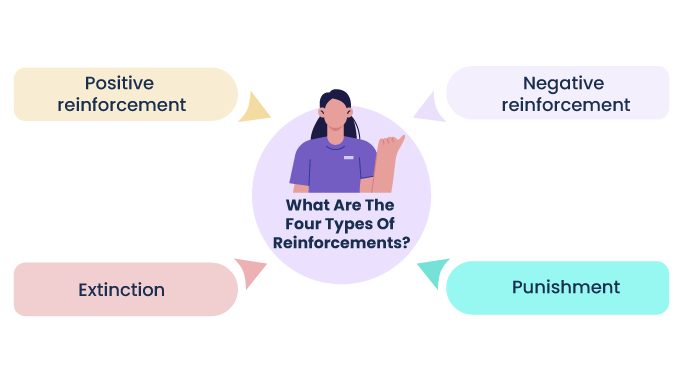A Mini Guide On How To Use Reinforcement Theory On Employees
While trying out new consequences to motivate employees, have you noticed a difference in behavior? If yes, then congratulations! You've successfully applied the reinforcement theory of motivation in your workplace!
To give you a better understanding of this theory, here is a simple example-
We have all seen how dogs who love to play fetch gets a treat when they bring back the ball. This act of giving the treat is a reinforcement. And a good one, at that. When you give your dog the treat after retrieving the ball, you are positively reinforcing their behavior. This increases the probability of the positive behavior to repeat itself itself over a period of time. In this case the positive behavior is fetching the ball.
Let's understand about it in detail.
What Is Reinforcement Theory?
Reinforcement theory is the assumption that we can alter our behaviors by changing the consequences. In other words, a person's behavior is motivated by the repercussions of the action.
Basically, positive behaviors get repeated due to the cause and effect relationship, while negative behaviors do not.
The History Behind Reinforcement Theory
E.L. Thorndike proposed this concept in 1911, which also came to be known as the "law of effect." On the other hand, BF Skinner has given the theory a tangible form by adding several modern ideas and interpretations.
Skinner explained that internal drives and desires do not matter in this type of motivation. It depends entirely on what happens after a person takes action. If the consequence is preferable, they are more likely to reoccur and not if they do not find it preferable. It is also known as 'Operant Conditioning'.
It is important that we understand the many types of reinforcements to grasp this idea. Let's have a peek.
What Are The Four Types Of Reinforcements?

Reinforcements are diverse. Therefore, an employer needs to know their staff and their needs before implementing it in a workspace.
Most of the time, we find a mismatch between the reinforcer and the employee, which results in a lack of the desired behavior.
For example, if your employee does not require money but appreciation, a bonus as a reinforcer will not be helpful.
The four kinds of reinforcements that managers uses are-
1. Positive Reinforcement
It is when the application of a specific positive outcome increases the probability of the behavior that follows the outcome to be repeated.
It implies that a positive response is given when an employee shows positive or acceptable behavior. This, in turn, motivates the employee to repeat the certain behavior.
A simple example would be rewarding employees for their work. It will not only motivate the individual to carry out the required task but also push them to be better at it.
Positive reinforcement is the perfect way to evoke desirable behaviors in your employees regularly. And since the reinforcers motivate the employees, they complete the tasks readily, leading to a very productive work environment.
2. Negative Reinforcement
It is when you remove a negative or unpleasant situation or consequence to increase the desired behavior. In this case, your employees are not rewarded for completing the task. Instead, it is done so by eliminating anything that is hindering their growth.
Let me put this across by an example. Let's say you transfer your employees to a new location every three years. But to boost performance, you created a new policy that states that top performers will not be transferred.
Believe me when I say that your employees will work twice as hard and produce better results to avoid the transfer. Here, they are not getting reinforced directly. The removal of the unwanted situation is amplifying the desired behavior.
3. Punishment
Punishment is the kind of reinforcement used to put an end to the recurrence of an unwanted behavior. In simpler terms, it means implementing an undesirable consequence for repeating an undesirable behavior.
In corporates, it means penalizing your employees for doing something restricted. Penalizing acts as a reinforcer that stops the employee from performing that task again.
Another way of punishing is suspending your employees for unwanted professional behavior. Punishment is usually used by managers as a last resort when other reinforcers are not working. This is because it might result in an inadequate response and stress out both the employee and the employer.
Punishments can be positive and negative too. Positive punishment involves adding something unappealing to minimize the behavior. On the contrary, a negative punishment consists of taking away something desirable, which helps stop that behavior.
Also, do not confuse negative reinforcement with punishment. Punishment gives a negative consequence, while negative reinforcement takes away the negative consequence.
4. Extinction
Extinction indicates eliminating a reinforcer to discourage workers from performing a learned action. In other words, it means removing a particular motivator when you want to stop the behavior that is supported by that motivator.
Unlike punishment, extinction does not provide a negative consequence but removes the reward that calls bad practices or conduct. Employees being denied overtime pay is one example of extinction in the workplace.
Employees are usually drawn to work on weekends and do overtime due to the extra pay and overtime benefits. When overtime pay is removed, the positive reinforcer is no longer available to motivate them. This will discourage them from working overtime. In this manner, the learned behavior stops when it is no longer needed.
It illustrates how management can avoid a learned or unwanted behavior by removing the desired reward.
It is also very important to know that extinction reinforcers may sometimes backfire.
When a specific positive reward is withheld, there may be some resentment and frustration. But, it is usually only in the beginning, after which employees gradually become used to it.
How Can You Use Reinforcement Theory In Your Workplace?

As a manager, you have to make sure you use the suitable reinforcer for the right employee. It is because a wrong reinforcer will create conflict and discontentment. Some factors on which the reinforcer and employee relationship will depend are-
1. Satisfaction Factor Of The Employee
For reinforcement to work, employees must find the reinforcers meaningful. If your employees are unsatisfied with the rewards and recognition, it will not inspire any motivation within them to pursue positive action.
2. Speediness
The time factor also plays a vital role in reinforcing an employee for positive motivation. If the gap between giving the reward and your employees' action is too long, it will not serve the cause. Your employees' level of motivation and the reinforcer's effect will depend on the timeliness and frequency of the reward.
3. Size Of The Reward
Size or the magnanimity of the reward is also critical for an employee to get positively reinforced. If the reward is too minute and the employee does not desire it at all, it will fail to impart a positive experience.
For example, a bigger promotion will give more motivation than a dry promotion.
In a nutshell, reinforcements act as a game of rewards and punishments in order to motivate your employees. Although all reinforcements are helpful, positive and negative reinforcements are more typically used to enrich a more acceptable behavior.
Few Things To Note Before Applying It In Your Workplace

Before you start motivating your employees, backed by this theory, here are a few things you might not want to miss.
Every person is different, and thus, each person will have a contrasting understanding of motivation.
- Some will get motivated by a word of appreciation
- Some others will get inspired by a quarterly bonus
- Again some will require extrinsic motivation from extrinsic rewards so on and so forth.
Thus, as an HR professional, you must understand your employees' wants and needs. It is the only course of action to organically motivate them. Few small factors that you can look after are-
1. Consequences Should Be Meaningful
An employee must feel connected with the consequences of the reinforcer so that they are motivated from within.
2. Fixed Interval Scheduled Between Rewards
A significant gap between the action and getting rewarded for it will cause your employees' expectations to fade. People are often less interested and less enthusiastic about delayed rewards and appreciations.
3. Use A Problem-Solving Approach
The approach while using a reinforcer should be problem-solving. The underlying undesirable actions must be determined and evaluated before implementing the solutions. It should be a collective effort of the leadership and the staff.
4. Communicate The Consequences
This is one of the most crucial factors before implementing a reinforcer. Without clarifying the consequences, the employees will not know why they are being reinforced. An absence of clarification will lead to confusion and conflict rather than motivation.
5. Understand Your Employees' Self-interest
Every employee is unique, so their motivational requirements also vary from person to person. Hence, knowing their self-interest is the only way through which you will know if the efforts are going to bring fruits.
6. Do Not Force The Situation
No good can happen if you make people do things forcefully. Resentment and frustration will build up, leading to a very toxic work environment. To avoid this, it is essential that you know your employees. Listen to them, understand what they are saying, define the expected behaviors, and finally reinforce their actions!
Takeaway
Like any other techniques and theory, Reinforcement theory will also be effective or ineffective, based on the situations and how it is applied.
Therefore, it is crucial to know your employees, study the situation before you motivate your employees. From an HR perspective, this is a very effective tool to encourage acceptable behavior and enhance employee motivation.

















